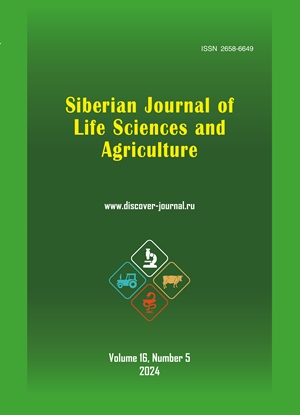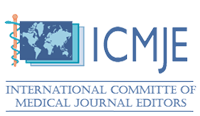ЭНТОМОФАГИ В СИСТЕМЕ ЗАЩИТЫ РАСТЕНИЙ ОГУРЦА
Аннотация
Актуальность обусловлена возросшими требованиями к качеству получаемой продукции, увеличением рыночной стоимости пестицидов и возрастающей резистентностью вредителей к ним. В условиях стремительного развития тепличных технологий в последние годы и возрастающей численности видового состава вредных организмов систему защиты растений нужно постоянно актуализировать. Целью работы стало получение экологически чистого продукта с меньшими финансовыми затратами без использования химических обработок посредством заселения и разведения в производственном блоке теплицы паразитарной осы (Aphidius colemani), как средства защиты от бахчевой тли (Aphis gossypii). Для выявления заселенности растений вредителями использовался метод мониторинговых цветных клеевых ловушек. Учет урожайности растений огурца проводили после каждого сбора, процент нестандартной продукции определяли путем визуального осмотра. Для получения высоко экологичного продукта питания разработали, апробировали и внедрили экспериментальную схему защиты от тли в осенний период с применением энтомофагов Aphidius colemani и Amblyseius swirski. Установили целесообразность внесения по 1 особи на один м2 каждую неделю в течение как минимум 6 недель, начиная с размещения рассады на постоянное место плодоношения. Если очагов не обнаруживали, спустя это время, норму внесения понижали. В случае обнаружения, очаг отмечали на карте и сразу вносили дополнительно Aphidius colemani в соотношении хищник:жертва как 1:10-20. Выявили, что экспериментальная схема применения энтомофагов является экологически безопасной и экономически выгодной: повысилась урожайность на 3,6 кг/м2, снизились производственные затраты (на 1,1 руб./кг) и, как результат, уровень рентабельности увеличился на 1,1 %.
Скачивания
Литература
Список литературы
Ахатов А.К. Мир огурца глазами фитопатолога. Москва: Товарищество научных изданий «КМК», 2020. 320 с.
Ахатов А.К. Практическое пособие по идентификации клещей и насекомых в овощных теплицах. Москва: Товарищество научных изданий «КМК», 2016. 94 с.
Басарыгина Е. М. Экологизированная защита растений в гидропонном овощеводстве / Е. М. Басарыгина, Р. И. Панова, Т. А. Путилова // Вестник Челябинской государственной агроинженерной академии. 2014. Т. 67, № 1. С. 5-8.
Белова М. К. Биологизированная система защиты огурца (Cucumis sativus) в защищенном грунте / М. К. Белова, С. С. Цыгикало // Защита растений от вредных организмов: Материалы XI международной научно-практической конференции, Краснодар, 19–23 июня 2023 года. Том Выпуск 11. Краснодар: Кубанский государственный аграрный университет имени И.Т. Трубилина, 2023. С. 50-52.
Белякова Н. А. Скрининг биоресурсов насекомых и клещей для биологического контроля вредителей в защищенном грунте / Н. А. Белякова, В. А. Павлюшин // Вестник защиты растений. 2023. Т. 106, № 1. С. 49-70. https://doi.org/10.31993/2308-6459-2023-106-1-15533
Белякова Н. А. Освоение биоресурсов энтомофагов: проблемы и дальнейшие пути развития / Н. А. Белякова, В. А. Павлюшин, Д. А. Попов // Труды Русского энтомологического общества / Под ред. С.А. Белокобыльского; Российская академия наук. Том 93. Санкт-Петербург: Русское энтомологическое общество, 2022. С. 5-20. https://doi.org/10.47640/1605-7678_2022_93_5
Гриценко В.В. Вредители и болезни сельскохозяйственных культур/ В.В. Гриценко, Ю.М. Стройков, Н.Н. Третьяков. Москва: Академия, 2012. 224 с.
Долженко Т.В. Биорациональные средства защиты растений // Известия Санкт-Петербургского государственного аграрного университета. 2011. № 23. С. 104-109.
Замотайлов А.С. История и методология биологической защиты растений. Электронный курс лекций. Краснодар, 2012. 237 с.
Козлова Е. Г. Опыт применения биосредств в защите огурца от комплекса вредителей в теплицах / Е. Г. Козлова, Л. П. Красавина, Г. С. Орлова // Защита и карантин растений. 2019. № 11. С. 39-42.
Культурная флора = Flora of cultivated plants. Тыквенные. Т. 21: (Огурец, дыня) / В.И. Пыженков, М.И. Малинина; Ред. В. И. Пыженков. Москва: Колос, 1994. 287 с.
Мехдиев Т. В. Экологические проблемы применения пестицидов // Сельскохозяйственные науки и агропромышленный комплекс на рубеже веков. 2014. № 5. С. 98-103.
Огурец: от посева до урожая / Портянкин А.Е., Шамшина А.В. (под общ.ред. С.Ф Гавриша). Москва: ООО «Гибридные семена «Гавриш» для НП НИИОЗГ: «Фитон+», 2010. 400с.
Справочник пестицидов и агрохимикатов, разрешенных к применению на территории Российской Федерации 2023. Москва, версия 59 от 13.01.2023.
Токарева А. К. Защита растений и повышение их продуктивности в условиях теплицы / А. К. Токарева, О. В. Петрушина // Разнообразие и устойчивое развитие агробиоценозов Омского Прииртышья: материалы Национальной научно-практической конференции, посвященной 90-летию ботанического сада Омского ГАУ, Омск, 25 сентября 2017 года. Омск: Омский государственный аграрный университет имени П.А. Столыпина, 2017. С. 70-72.
Emaru A., Gaoqiong L., Rwotonen I.B. Green pest management: A case study of Aphidius colemani, Viereck, a biological control agent // Int. J. Phytol. Res. 2023. Vol. 3, No. 4. P. 22–30.
Adly D., Mahmoud Ibrahim H., Mohamed Salleh A. E. H. Synergistic effects of Aphidius colemani (Hymenoptera: Aphidiidae) and Coccinella undecimpunctata (Coleoptera: Coccinellidae) releases for the biological control of Diuraphis noxia in wheat fields // Biocontrol Science and Technology. 2023. P. 1-16. https://doi.org/10.1080/09583157.2023.2277652
Diwas Khatri, Xiong Z He, Qiao Wang, Potential Aphid Population Regulation by Aphidius colemani (Hymenoptera: Aphidiidae) in Response to Host Density, Parasitoid Density, and Age // Journal of Economic Entomology. 2021. Vol. 114, Issue 4. P. 1847–1851. https://doi.org/10.1093/jee/toab090
Jerbi-Elayed M., Foray V., Tougeron K., Grissa-Lebdi K., Hance T. Develop-mental Temperature Affects Life-History Traits and Heat Tolerance in the Aphid Parasitoid Aphidius colemani // Insects. 2021. Vol. 12, 852. https://doi.org/10.3390/insects12100852
Marinchenko T. Entomophages as a Perspective Direction of Plant Protection // KnE Life Sciences. 2021. Vol. 6(3). P. 374–383. https://doi.org/10.18502/kls.v0i0.8968
Moreno-Delafuente A. et al. Elevated carbon dioxide reduces Aphis gossypii in-trinsic increase rates without affecting Aphidius colemani parasitism rate // Biological Control. 2021. Vol. 163. P. 104741. https://doi.org/10.1016/j.biocontrol.2021.104741
Pirayeshfar F., Safavi S.A., Moayeri H.R.S. et al. Provision of astigmatid mites as supplementary food increases the density of the predatory mite Amblyseius swirskii in greenhouse crops, but does not support the omnivorous pest, western flower thrips // BioControl. 2021. Vol. 66. P. 511–522. https://doi.org/10.1007/s10526-021-10092-9
References
Akhatov A.K. The world of cucumber through the eyes of phytopathologist. Moscow: Partnership of scientific editions “KMK”, 2020, 320 p.
Akhatov A.K. Practical guide to the identification of mites and insects in vegetable greenhouses. Moscow: Partnership of scientific publications “KMK”, 2016, 94 p.
Basarygina E. M. Ecologized plant protection in hydroponic vegetable growing / E. M. Basarygina, R. I. Panova, T. A. Putilova. Bulletin of Chelyabinsk State Agroengineering Academy, 2014, vol. 67, no. 1, pp. 5-8.
Belova M. K. Biologized system of protection of cucumber (Cucumis sativus) in protected ground / M. K. Belova, S. S. Tsygikalo. Plant protection from pests: Proceedings of the XI International Scientific and Practical Conference, Krasnodar, 19-23 June 2023. Vol. Issue 11. Krasnodar: Kuban State Agrarian University named after I.T. Trubilin, 2023, pp. 50-52.
Belyakova N. A. Screening of bioresources of insects and mites for biological control of pests in protected soil / N. A. Belyakova, V. A. Pavlyushin. Plant Protection Bulletin, 2023, vol. 106, no. 1, pp. 49-70. https://doi.org/10.31993/2308-6459-2023-106-1-15533
Belyakova N. A. Development of bioresources of entomophages: problems and further ways of development / N. A. Belyakova, V. A. Pavlyushin, D. A. Popov. Proceedings of the Russian Entomological Society / Edited by S. A. Belokobylsky; Russian Academy of Sciences. Vol. 93. St. Petersburg: Russian Entomological Society, 2022, pp. 5-20. https://doi.org/10.47640/1605-7678_2022_93_5
Gritsenko V.V. Pests and diseases of agricultural crops / V.V. Gritsenko. Gritsenko, Y.M. Stroikov, N.N. Tretyakov. Moscow: Academy, 2012, 224 p.
Dolzhenko T.V. Biorational means of plant protection. Izvestiya St. Petersburg State Agrarian University, 2011, no. 23, pp. 104-109.
Zamotaylov A.S. History and methodology of biological plant protection. Electronic course of lectures. Krasnodar, 2012, 237 p.
Kozlova E. G. Experience in the use of bio-mediators in the protection of cucumber from a complex of pests in greenhouses / E. G. Kozlova, L. P. Krasavina, G. S. Orlova. Plant Protection and Quarantine, 2019, no. 11, pp. 39-42.
Cultivated flora. Pumpkin plants. Vol. 21: (Cucumber, melon) / V.I. Pyzhenkov, M.I. Malinina; Ed. V.I. Pyzhenkov. Moscow: Kolos, 1994, 287 p.
Mehdiyev T. V. Ecological problems of pesticide use. Agricultural sciences and agroindustrial complex at the turn of the century, 2014, no. 5, pp. 98-103.
Cucumber: from sowing to harvest / Portyankin A.E., Shamshina A.V. (edited by S.F. Gavrish). Moscow: LLC “Hybrid seeds Gavrish” for NP NIIOZG: “Fiton +”, 2010, 400 p.
Directory of pesticides and agrochemicals authorized for use on the territory of the Russian Federation 2023. Moscow, version 59, 13.01.2023.
Tokareva A. K. Plant protection and increasing their productivity in greenhouse conditions / A. K. Tokareva, O. V. Petrushina. Diversity and sustainable development of agrobiocenoses of Omsk Priirtyshye: Proceedings of the National Scientific and Practical Conference dedicated to the 90th anniversary of the Botanical Garden of Omsk GAU, Omsk, September 25, 2017. Omsk: Omsk State Agrarian University named after P.A. Stolypin, 2017, pp. 70-72.
Emaru A., Gaoqiong L., Rwotonen I.B. Green pest management: A case study of Aphidius colemani, Viereck, a biological control agent. Int. J. Phytol. Res., 2023, vol. 3, no. 4, pp. 22-30.
Adly D., Mahmoud Ibrahim H., Mohamed Salleh A. E. H. Synergistic effects of Aphidius colemani (Hymenoptera: Aphidiidae) and Coccinella undecimpunctata (Coleoptera: Coccinellidae) releases for the biological control of Diuraphis noxia in wheat fields. Biocontrol Science and Technology, 2023, pp. 1-16. https://doi.org/10.1080/09583157.2023.2277652
Diwas Khatri, Xiong Z He, Qiao Wang, Potential Aphid Population Regulation by Aphidius colemani (Hymenoptera: Aphidiidae) in Response to Host Density, Parasitoid Density, and Age. Journal of Economic Entomology, 2021, vol. 114, issue 4, pp. 1847-1851. https://doi.org/10.1093/jee/toab090
Jerbi-Elayed M., Foray V., Tougeron K., Grissa-Lebdi K., Hance T. Develop-mental Temperature Affects Life-History Traits and Heat Tolerance in the Aphid Parasitoid Aphidius colemani. Insects, 2021, vol. 12, 852. https://doi.org/10.3390/insects12100852
Marinchenko T. Entomophages as a Perspective Direction of Plant Protection. KnE Life Sciences, 2021, vol. 6(3), pp. 374-383. https://doi.org/10.18502/kls.v0i0.8968
Moreno-Delafuente A. et al. Elevated carbon dioxide reduces Aphis gossypii in-trinsic increase rates without affecting Aphidius colemani parasitism rates. Biological Control, 2021, vol. 163, p. 104741. https://doi.org/10.1016/j.biocontrol.2021.104741
Pirayeshfar F., Safavi S.A., Moayeri H.R.S. et al. Provision of astigmatid mites as supplementary food increases the density of the predatory mite Amblyseius swirskii in greenhouse crops, but does not support the omnivorous pest, western flower thrips. BioControl, 2021, vol. 66, pp. 511-522. https://doi.org/10.1007/s10526-021-10092-9
Просмотров аннотации: 88 Загрузок PDF: 47
Copyright (c) 2024 Roman V. Shchuchka, Valentina A. Gulidova, Tatyana V. Zubkova, Olga A. Dubrovina, Vyacheslav L. Zakharov

Это произведение доступно по лицензии Creative Commons «Attribution-NonCommercial-NoDerivatives» («Атрибуция — Некоммерческое использование — Без производных произведений») 4.0 Всемирная.






















































